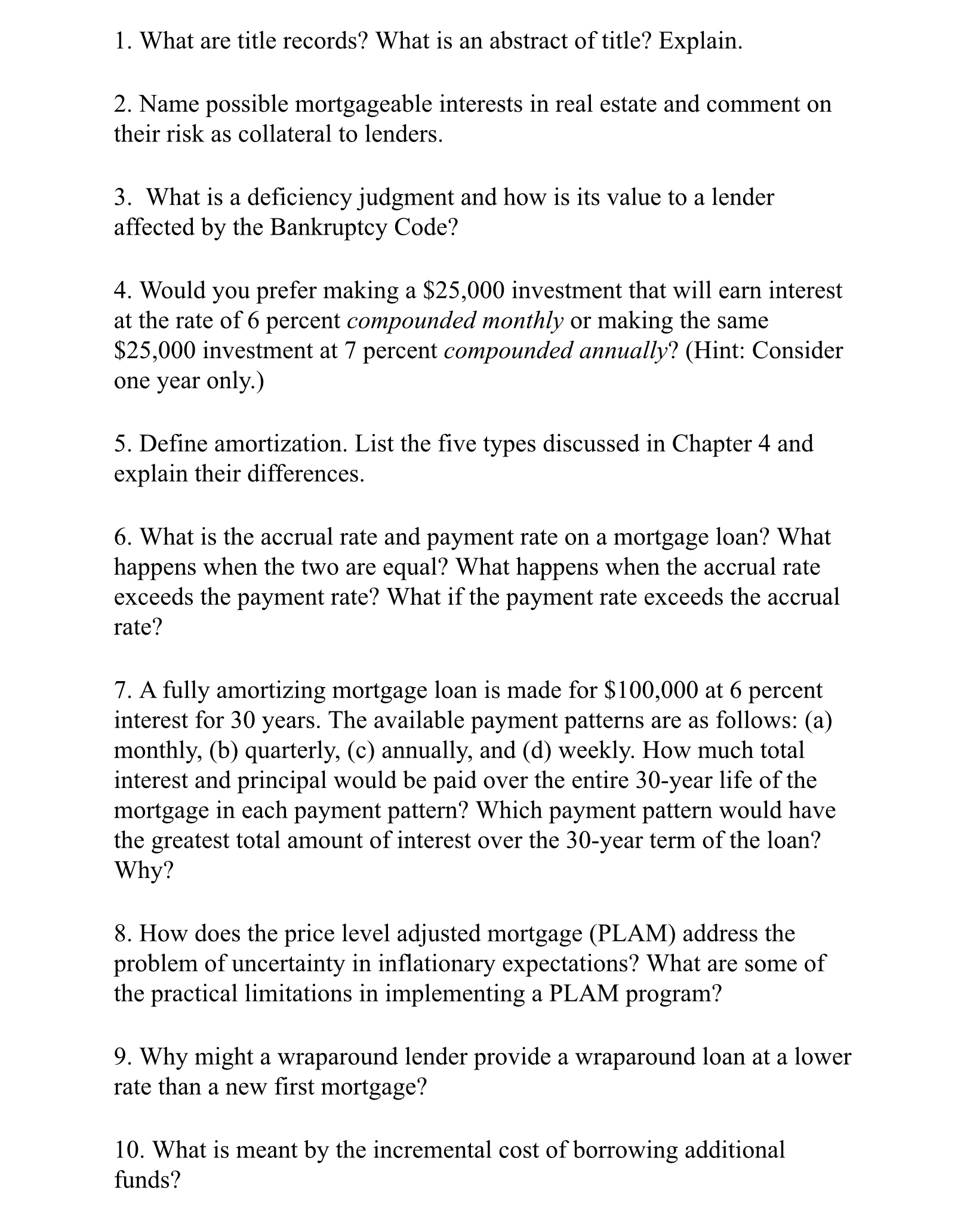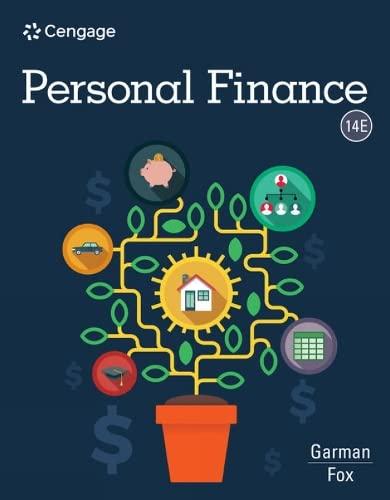Answered step by step
Verified Expert Solution
Question
1 Approved Answer
Need help with #5,#7,#10 1. What are title records? What is an abstract of title? Explain. 2. Name possible mortgageable interests in real estate and
Need help with #5,#7,#10

 1. What are title records? What is an abstract of title? Explain. 2. Name possible mortgageable interests in real estate and comment on their risk as collateral to lenders. 3. What is a deficiency judgment and how is its value to a lender affected by the Bankruptcy Code? 4. Would you prefer making a $25,000 investment that will earn interest at the rate of 6 percent compounded monthly or making the same $25,000 investment at 7 percent compounded annually? (Hint: Consider one year only.) 5. Define amortization. List the five types discussed in Chapter 4 and explain their differences. 6. What is the accrual rate and payment rate on a mortgage loan? What happens when the two are equal? What happens when the accrual rate exceeds the payment rate? What if the payment rate exceeds the accrual rate? 7. A fully amortizing mortgage loan is made for $100,000 at 6 percent interest for 30 years. The available payment patterns are as follows: (a) monthly, (b) quarterly, (c) annually, and (d) weekly. How much total interest and principal would be paid over the entire 30-year life of the mortgage in each payment pattern? Which payment pattern would have the greatest total amount of interest over the 30-year term of the loan? Why? 8. How does the price level adjusted mortgage (PLAM) address the problem of uncertainty in inflationary expectations? What are some of the practical limitations in implementing a PLAM program? 9. Why might a wraparound lender provide a wraparound loan at a lower rate than a new first mortgage? 10. What is meant by the incremental cost of borrowing additional funds? 1. What are title records? What is an abstract of title? Explain. 2. Name possible mortgageable interests in real estate and comment on their risk as collateral to lenders. 3. What is a deficiency judgment and how is its value to a lender affected by the Bankruptcy Code? 4. Would you prefer making a $25,000 investment that will earn interest at the rate of 6 percent compounded monthly or making the same $25,000 investment at 7 percent compounded annually? (Hint: Consider one year only.) 5. Define amortization. List the five types discussed in Chapter 4 and explain their differences. 6. What is the accrual rate and payment rate on a mortgage loan? What happens when the two are equal? What happens when the accrual rate exceeds the payment rate? What if the payment rate exceeds the accrual rate? 7. A fully amortizing mortgage loan is made for $100,000 at 6 percent interest for 30 years. The available payment patterns are as follows: (a) monthly, (b) quarterly, (c) annually, and (d) weekly. How much total interest and principal would be paid over the entire 30-year life of the mortgage in each payment pattern? Which payment pattern would have the greatest total amount of interest over the 30-year term of the loan? Why? 8. How does the price level adjusted mortgage (PLAM) address the problem of uncertainty in inflationary expectations? What are some of the practical limitations in implementing a PLAM program? 9. Why might a wraparound lender provide a wraparound loan at a lower rate than a new first mortgage? 10. What is meant by the incremental cost of borrowing additional funds
1. What are title records? What is an abstract of title? Explain. 2. Name possible mortgageable interests in real estate and comment on their risk as collateral to lenders. 3. What is a deficiency judgment and how is its value to a lender affected by the Bankruptcy Code? 4. Would you prefer making a $25,000 investment that will earn interest at the rate of 6 percent compounded monthly or making the same $25,000 investment at 7 percent compounded annually? (Hint: Consider one year only.) 5. Define amortization. List the five types discussed in Chapter 4 and explain their differences. 6. What is the accrual rate and payment rate on a mortgage loan? What happens when the two are equal? What happens when the accrual rate exceeds the payment rate? What if the payment rate exceeds the accrual rate? 7. A fully amortizing mortgage loan is made for $100,000 at 6 percent interest for 30 years. The available payment patterns are as follows: (a) monthly, (b) quarterly, (c) annually, and (d) weekly. How much total interest and principal would be paid over the entire 30-year life of the mortgage in each payment pattern? Which payment pattern would have the greatest total amount of interest over the 30-year term of the loan? Why? 8. How does the price level adjusted mortgage (PLAM) address the problem of uncertainty in inflationary expectations? What are some of the practical limitations in implementing a PLAM program? 9. Why might a wraparound lender provide a wraparound loan at a lower rate than a new first mortgage? 10. What is meant by the incremental cost of borrowing additional funds? 1. What are title records? What is an abstract of title? Explain. 2. Name possible mortgageable interests in real estate and comment on their risk as collateral to lenders. 3. What is a deficiency judgment and how is its value to a lender affected by the Bankruptcy Code? 4. Would you prefer making a $25,000 investment that will earn interest at the rate of 6 percent compounded monthly or making the same $25,000 investment at 7 percent compounded annually? (Hint: Consider one year only.) 5. Define amortization. List the five types discussed in Chapter 4 and explain their differences. 6. What is the accrual rate and payment rate on a mortgage loan? What happens when the two are equal? What happens when the accrual rate exceeds the payment rate? What if the payment rate exceeds the accrual rate? 7. A fully amortizing mortgage loan is made for $100,000 at 6 percent interest for 30 years. The available payment patterns are as follows: (a) monthly, (b) quarterly, (c) annually, and (d) weekly. How much total interest and principal would be paid over the entire 30-year life of the mortgage in each payment pattern? Which payment pattern would have the greatest total amount of interest over the 30-year term of the loan? Why? 8. How does the price level adjusted mortgage (PLAM) address the problem of uncertainty in inflationary expectations? What are some of the practical limitations in implementing a PLAM program? 9. Why might a wraparound lender provide a wraparound loan at a lower rate than a new first mortgage? 10. What is meant by the incremental cost of borrowing additional funds Step by Step Solution
There are 3 Steps involved in it
Step: 1

Get Instant Access to Expert-Tailored Solutions
See step-by-step solutions with expert insights and AI powered tools for academic success
Step: 2

Step: 3

Ace Your Homework with AI
Get the answers you need in no time with our AI-driven, step-by-step assistance
Get Started


